- More than 2 years ago
Stabilizing the ties that bind a protein important in Parkinson’s disease to its buddies might help fend off the disease, a new study of the protein’s structure suggests.
Alpha-synuclein builds up in tough aggregates in the brains of patients with Parkinson’s disease. Researchers thought that this protein was normally a floppy, snakelike molecule.
But now, neuroscientist and neurologist Dennis Selkoe of Brigham and Women’s Hospital and Harvard Medical School and his colleagues show that alpha-synuclein normally forms bands of four molecules in living cells. These quartets (scientists call them tetramers) of alpha-synuclein molecules resist the clumping that leads single molecules of the protein down the path to brain cell destruction, Selkoe and colleagues report online August 14 in Nature.
Discovering that alpha-synuclein works in groups of four could be important in treating or preventing Parkinson’s disease, says Patrik Brundin, a neuroscientist at Lund University in Sweden. The findings suggest that loner alpha-synuclein molecules could be “part of the ‘bad guy’ pathway, and stabilizing it as a tetramer might help avoid the disease,” he says.
No one yet knows whether quartets of alpha-synuclein disintegrate into single molecules in the brains of people with Parkinson’s disease, leading to big brain-cell-killing plaques. Studies comparing normally aging brains with those of people with the disease may help answer those and other questions raised by the study, Brundin says.
The new discovery may also help researchers figure out what alpha-synuclein’s day job is, says Joakim Bergström, a molecular biologist and biochemist at Uppsala University in Sweden. The protein was thought to be important in grasping lipids — fats and other molecules that make up membranes, carry messages and perform other functions in a cell — but earlier experiments have given mixed results. In the new study, the researchers found that the alpha-synuclein quartet can hold much more lipid than single molecules of the protein can.
The finding that the protein hangs out in groups of four “potentially explains a lot of contradictory information in the literature,” about alpha-synuclein’s behavior, says Chad Rienstra, a structural biologist at the University of Illinois at Urbana-Champaign.
Rienstra suggests that contradictory information may have come from the way scientists produce samples of the protein for study. Most researchers studying the protein induce bacteria to make large quantities of the molecule.
But the bacteria-produced version of the protein doesn’t fold up the same way as it does in human cells, Selkoe’s group found. In human red blood and brain cells, the protein winds up into spiral structures called alpha helices and then forms hardy four-man bands.
Even so, it’s far too soon to throw out decades of data suggesting that the protein is a loner, says Hilal Lashuel, a protein biochemist at the Swiss Federal Institute of Technology in Lausanne. The group’s claims “should be treated with caution until reproduced,” he says. That’s something he has tried to do without success since hearing about the study at a meeting earlier this year.
Lashuel is concerned about some of the experimental methods used in the study and the group’s interpretation of the results, which may have larger implications for Parkinson’s disease research. “I’m worried that people will start questioning all the previous data,” he says. Abandoning that previous work could prove costly if the new finding ultimately doesn’t pan out, he says. “My view is that any time we waste, we take away from patients and their families.”






